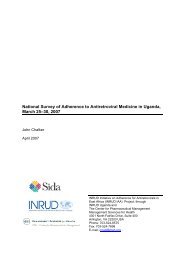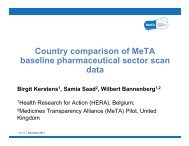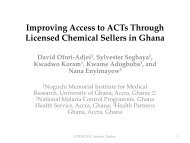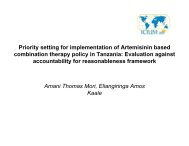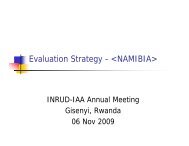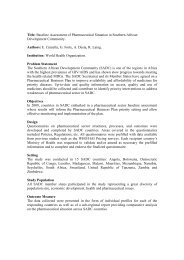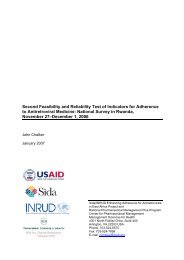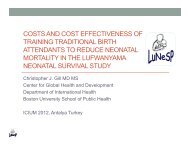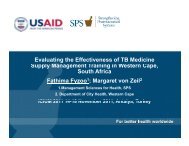How to investigate levels of Adherence to antiretroviral ... - INRUD
How to investigate levels of Adherence to antiretroviral ... - INRUD
How to investigate levels of Adherence to antiretroviral ... - INRUD
You also want an ePaper? Increase the reach of your titles
YUMPU automatically turns print PDFs into web optimized ePapers that Google loves.
<strong>How</strong> <strong>to</strong> Investigate <strong>Adherence</strong> <strong>to</strong> Antiretroviral Treatment:<br />
An Indica<strong>to</strong>r-Based Approach<br />
It is also helpful if at least two members <strong>of</strong> the team have the ability <strong>to</strong> enter data on<strong>to</strong> a<br />
computer quickly and reliably.<br />
Plan data collection visits schedule<br />
As stated above, the team <strong>of</strong> three or four data collec<strong>to</strong>rs with a team leader can manage one<br />
facility in one day and double-enter the data on the lap<strong>to</strong>p (if available) the same day.<br />
<strong>How</strong>ever, they need <strong>to</strong> arrive at the facility at or before opening time, so that they can begin<br />
<strong>to</strong> draw the retrospective sample and the corresponding notes before the clinic becomes very<br />
busy. This means that the team needs <strong>to</strong> sleep near the facility.<br />
If the required sample is 20 facilities then four teams <strong>of</strong> data collec<strong>to</strong>rs can manage that in<br />
five working days (or two teams in 10 days), provided that the facilities are reasonably close<br />
<strong>to</strong>gether and they can spend the night near the next day’s facility. So logistically, the 20<br />
facilities need <strong>to</strong> be divided in<strong>to</strong> four groups and one team assigned <strong>to</strong> each group. At the<br />
end <strong>of</strong> the day <strong>of</strong> data collection, the team needs <strong>to</strong> travel <strong>to</strong>wards the next facility and sleep<br />
there. This requires careful planning and a dedicated vehicle for each team for the duration.<br />
The teams should stay <strong>to</strong>gether at night so that they can easily assemble and go <strong>to</strong> the<br />
facility as a group. If the team does not arrive early, the whole day can easily be <strong>of</strong>f schedule<br />
because the staff members are <strong>to</strong>o busy <strong>to</strong> collaborate.<br />
It is important that the survey day is also the day patients are expected. This means that<br />
apart from geographic proximity, each facility’s clinic schedule needs <strong>to</strong> be taken in<strong>to</strong><br />
account. To find this out, it will be necessary <strong>to</strong> call the facility’s ARV clinic <strong>to</strong> find which<br />
days they expect enough patients <strong>to</strong> do the exit interviews. Without careful preparation, it is<br />
all <strong>to</strong>o common that some facilities have no patients on the day <strong>of</strong> data collection.<br />
Every facility should be <strong>to</strong>ld in advance when <strong>to</strong> expect data collec<strong>to</strong>rs' visits. When funds<br />
permit, it can be useful <strong>to</strong> "hire" one or more staff at each facility <strong>to</strong> assist the data collec<strong>to</strong>rs<br />
in finding records and deciphering handwriting.<br />
For each facility chosen, the survey team should contact the head <strong>of</strong> the facility <strong>to</strong> explain<br />
the purpose <strong>of</strong> the work, provide a letter from the National AIDS Control Programme, and<br />
ask the facility for consent and assistance.<br />
Create the medicines lists<br />
The coordina<strong>to</strong>rs will need <strong>to</strong> create lists for essential adult ARVs, paediatric ARVs, and<br />
non-ARV key medicines. These lists should all be prepared in conjunction with the team<br />
leaders before the field work begins. First-line ART treatment medicines for adults and for<br />
children are recommended for the two ART lists; and treatment guidelines for the common<br />
opportunistic infections should be used <strong>to</strong> construct the key medicines list. Staff from the<br />
NACP may assist with this task. See the previous chapter for how <strong>to</strong> modify the forms.<br />
62



